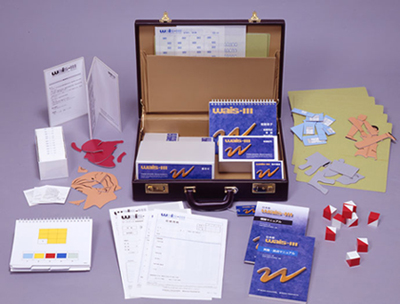Wechsler adult intelligence scale
From Psy3242
Contents |
Wechsler Adult Intelligence Scale (WAIS)
The Wechsler Adult Intelligence Scale is a general test of intelligence (IQ). The predecessor to this test was the Wechsler-Bellevue Intelligence Scale which was created in 1939. This testing scale was replaced by David Wechsler’s range of intelligence tests in 1955.
Dr. David Wechsler the creator of WAIS
Development and Revision
Several versions of this test have appeared since its creation. There are also different versions of this test in different countries. Revisions to the test in 1981 modified it to the WAIS-R. This test was standardized in the United States by testing a sample of 1,800 people from ages 16-74. The subjects were equally broken down into 9 age groups. There were equal numbers of men and women as well as white and nonwhite individuals which corresponded to figures from the census. The sample was further broken down into four geographic locations for the country. There was an attempt to balance between urban and rural subjects in the sample. Furthermore the subjects used in the sample were divided into six occupational groups. Thus, the standardization of the test was done in a manner in which to achieve a strong representative sample of the entire population in order to get accurate measures of intelligence. This scale has high levels of validity and reliability. The mean IQ for each of the age groups was a score of 100, with a standard deviation of 15. The current version of this test is the WAIS-III. This revision was made in the United States in 1997. It contains nearly 80% of the original test, along with improvements which attempt to make the scale culturally fair.
The tests measure intelligence in verbal and performance abilities. There are a total of 14 subtests. There are 7 verbal subtests and 7 performance subtests. The tests provide three scores: a verbal IQ, a performance IQ, and a full-scale IQ which is a composite of the combined scores.
The Verbal Subtests
-Information: Degree of general information acquired from culture
-Comprehension: Ability to deal with abstract social conventions, rules and expressions
-Arithmetic: Concentration while manipulating mental mathematical problems
-Similarities: Abstract verbal reasoning
-Vocabulary: The degree to which one has learned, been able to comprehend and verbally express vocabulary
-Digit span: For attention and concentration
-Letter-Number Sequencing: Attention and working memory
The Performance Subtests
-Picture Completion: Ability to quickly perceive visual details
-Digit Symbol or Coding: Visual-motor coordination, motor and mental speed
-Block Design: Spatial perception, visual abstract processing & problem solving
-Matrix Reasoning: Nonverbal abstract problem solving, inductive reasoning, spatial reasoning
-Picture Arrangement: Logical/sequential reasoning, social insight
-Symbol Search: Visual perception, speed
-Object Assembly: Visual analysis, synthesis, and construction
Use with the Brain-Damaged
With the separate tests and subtests it is possible to measure IQ in individuals who cannot complete either the verbal or performance components. Thus, individuals who are not able to comprehend or manage language can be tested through the performance tests for intelligence. Likewise the IQ of individuals that have visual or motor deficits can be calculated from the verbal tests alone. Neurologists often test patients with brain damage with subsections of the Wechsler Adult Intelligence Scale. This is done in order to make links between test performance and which areas in the brain have been damaged. Specific subsets may even be used to measure the extent of damage to specific brain areas. A different WAIS is often used for these purposes. It is the Wechsler Adult Intelligence Test Scale-Revised as a Neuropsychological Instrument. This intelligence scale is calculated with brain-damaged norms, thus, it is appropriate for comparisons among brain damaged individuals.
Other Wechsler Intelligence tests
There are three main types of Wechsler intelligence tests. They are focused on specific age groups. The first of these is Wechsler Pre-school and Primary Scale of Intelligence (WPPSI) which is specific to children ages 3-7. Another is the Wechsler Intelligence scale for Children (WISC) which is appropriate for use on children aged 7 to 16. Finally the Wechsler Adult Intelligence Scale (WAIS) is used in accurately measuring the intelligence of people aged 16 and older.


